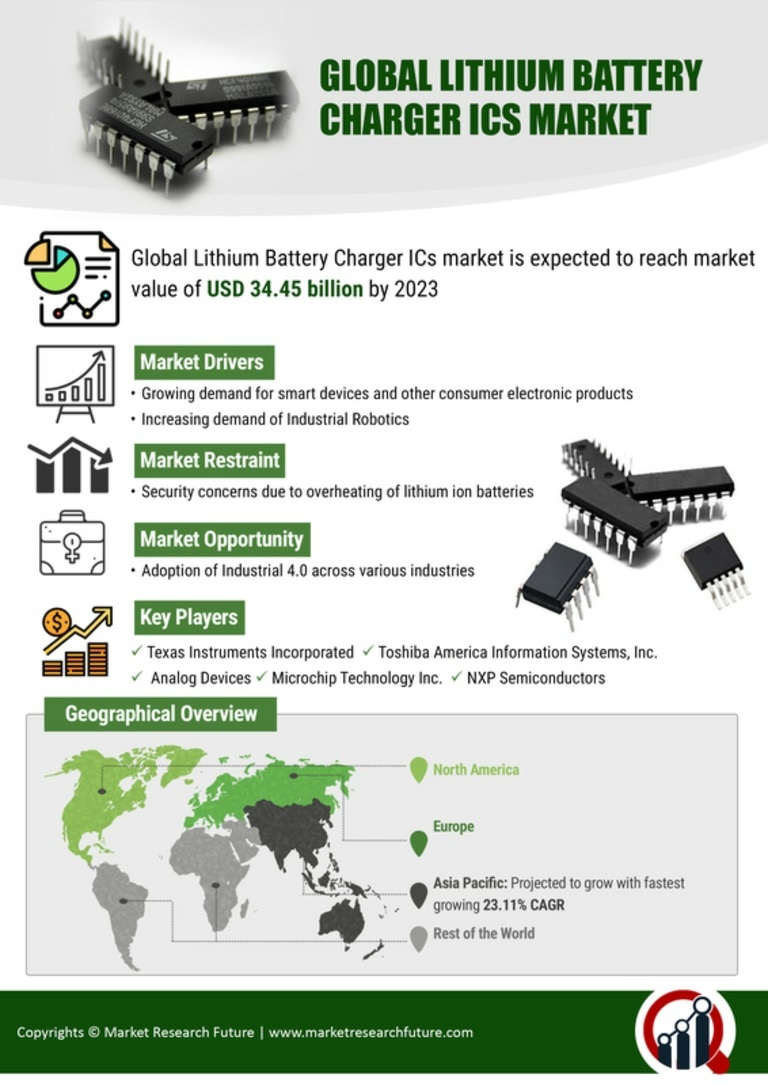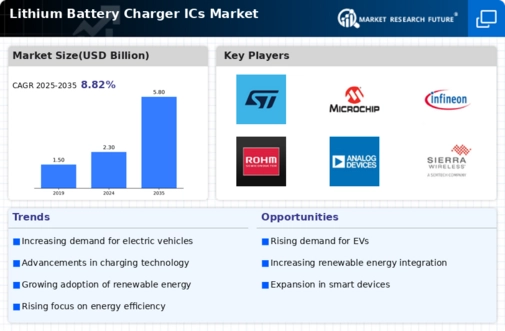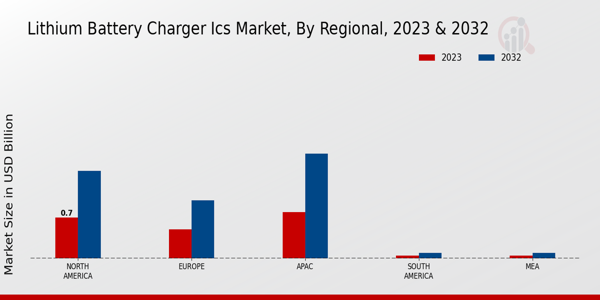Market Growth Projections
The Global Lithium Battery Charger ICs Market Industry is poised for substantial growth, with projections indicating a market value of 2.3 USD Billion in 2024 and an anticipated increase to 5.8 USD Billion by 2035. This growth trajectory suggests a compound annual growth rate (CAGR) of 8.78% from 2025 to 2035. Such figures reflect the increasing integration of lithium battery charger ICs across various applications, including consumer electronics, electric vehicles, and renewable energy systems. The market's expansion is indicative of the broader trends towards electrification and energy efficiency, positioning lithium battery charger ICs as critical components in the evolving technological landscape.
Growth of Electric Vehicles
The electric vehicle (EV) sector is experiencing unprecedented growth, which significantly influences the Global Lithium Battery Charger ICs Market Industry. As governments worldwide implement stringent emission regulations and promote sustainable transportation, the demand for efficient charging solutions for EVs is surging. This sector is expected to contribute substantially to the market, with projections indicating a market value of 5.8 USD Billion by 2035. The integration of advanced lithium battery charger ICs in EV charging infrastructure is essential for optimizing charging times and enhancing battery longevity, thus driving further market expansion.
Expansion of Renewable Energy Sources
The global shift towards renewable energy sources is influencing the Global Lithium Battery Charger ICs Market Industry. As solar and wind energy become more mainstream, the need for efficient energy storage solutions, including lithium batteries, is rising. This trend necessitates the development of advanced charger ICs that can optimize the charging process for renewable energy systems. The integration of lithium battery charger ICs in energy storage applications is expected to drive market growth, as these solutions enhance the efficiency and reliability of energy storage systems, thus supporting the broader transition to sustainable energy.
Increasing Focus on Energy Efficiency
The growing emphasis on energy efficiency across various sectors is a significant driver for the Global Lithium Battery Charger ICs Market Industry. As industries and consumers alike seek to reduce energy consumption and minimize environmental impact, the demand for energy-efficient charging solutions is escalating. Lithium battery charger ICs that offer improved efficiency and reduced energy losses are becoming essential components in electronic devices and electric vehicles. This trend is likely to foster innovation and competition among manufacturers, further propelling market growth as they strive to meet the evolving demands of energy-conscious consumers.
Rising Demand for Portable Electronics
The increasing proliferation of portable electronic devices such as smartphones, tablets, and wearables is a primary driver of the Global Lithium Battery Charger ICs Market Industry. As consumers demand longer battery life and faster charging capabilities, manufacturers are compelled to integrate advanced lithium battery charger ICs into their products. This trend is evidenced by the projected market value of 2.3 USD Billion in 2024, reflecting a robust growth trajectory. The shift towards compact and efficient charging solutions is likely to enhance the adoption of lithium battery charger ICs, thereby propelling the overall market forward.
Technological Advancements in Charging Solutions
Innovations in charging technology are reshaping the landscape of the Global Lithium Battery Charger ICs Market Industry. Developments such as fast charging, wireless charging, and smart charging solutions are becoming increasingly prevalent. These advancements not only improve user experience but also enhance the efficiency and safety of lithium battery chargers. As manufacturers strive to meet consumer expectations for rapid and convenient charging, the adoption of sophisticated lithium battery charger ICs is likely to increase. This trend suggests a sustained growth rate, with a projected CAGR of 8.78% from 2025 to 2035, indicating a vibrant future for the market.
























